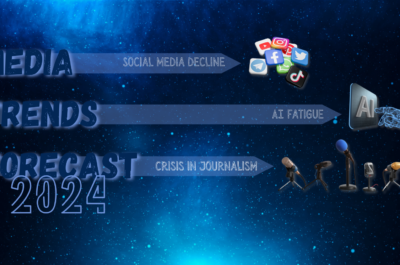The trend towards short-form content was proclaimed to have revolutionised the way people consume and create.
In recent years, we were all made to believe that with the decline of the average user’s attention span, short-form content would dominate the social media landscape, capturing users’ attention with its quick and engaging format. It began with TikTok, the popular short-form video platform that has taken the world by storm since its launch in 2016. With its addictive algorithm, user-friendly interface, and vast collection of creative content, TikTok has become a cultural phenomenon and a dominant force in the social media landscape.
The trend towards short-form content was proclaimed to have revolutionised the way people consume and create. Other platforms have launched features aimed at capturing the short-form video market, attempting to replicate TikTok’s success. Among them Instagram’s Reels, Facebook’s Meta and YouTube Shorts. Even Spotify changed its interface earlier this year, with new design going heavy on imagery and vertical scrolling, turning the homescreen from a set of album covers into a feed that much more closely resembles TikTok and Instagram.
But a closer look at recent developments suggests that the popularity of short-form content is experiencing a decline. And there is quite a lot of evidence of that. Let’s start with Meta (former Facebook), who placed a lot of bets on Instagram Reels as its answer to TikTok. However, last year’s leaked Meta’s internal report titled “Creators x Reels State of the Union 2022” said that the Instagram users cumulatively spent 17.6 million hours a day watching Reels, less than one-tenth of the 197.8 million hours TikTok users spent each day on that platform. The document also confirmed falling engagement rates and even said that “most Reels users have no engagement whatsoever.” Besides, Instagram has struggled to recruit people to make content. Meta denied internal documents that claimed the platform was falling behind TikTok. The problem, however, is real — last year Meta was the worst performing stock in the S&P 500. Mark Zuckerberg has personally lost more than $100 billion, with $11 billion in a single day. This may explain why industry experts did not really believe in the denial of the report’s authenticity and took it as an indication of a shift in user preferences towards more dynamic and immersive content experiences.
TikTok, the leader of the short-form video content industry, is also not doing very well— time spent with TikTok has been on the decline for a while, and new numbers show just how quickly the decline is taking place. For over a year and a half there has been a decrease in the number of viral hits. There is more to it — Billboard highlights a surprising trend where viral TikTok hit songs do not necessarily translate into streaming success. This challenges the notion that short-form content automatically drives engagement and boosts artists’ popularity. It also raises questions about the long-term impact and effectiveness of short-form content in the music industry.
In May 2023, Adweek conducted an analysis of TikTok video performance, which showed that “videos with over 10 million views peaked in February 2022 at 9,259 per week; that’s dropped to less than 4,600 videos per week in April 2023. In short, just over a year ago, there were more than double the number of viral videos”. Adweek also looked at the performance of videos with more than 10,000 views and those with over 100,000 views, and in both categories, average views per video had fallen steadily since a peak in December 2022. Creators with 100,000 followers have seen a 30,000 average drop in views. The conclusion which Adweek makes? “The era of instant virality is receding.” It seems that TikTok’s user base may have reached its peak and that user growth is now stagnating. Tiktok still enjoys a large user base, but users are spending less time actively engaging with the content. It could indicate a fatigue or saturation with short-form videos, leading users to seek alternative forms of entertainment.
And this is happening across all social media platforms, with dire consequences for brands. A report from February 2023 shows that the average engagement rate on Facebook for brands is remarkably low. Sports teams and influencers receive an average engagement of 0.27% and 0.2% respectively from their Facebook followers. However, when considering all industries, the median engagement rate is a mere 0.064%. This suggests that while it is relatively easy to gain fans on Facebook, only a small fraction of them actually interact with the brand’s content. Moreover, Facebook’s engagement rate has consistently declined in recent years. It was 0.09% in 2019, dropped to 0.08% in 2020, and reached a low of 0.064% in 2021. With less than 0.1% of followers interacting with content, one can argue that having a presence on a social media platform with such low engagement rates might not be worthwhile.
In comparison, Instagram fares slightly better in terms of engagement, although its rate has also decreased from 0.9% in 2021 to 0.67%. However, both Facebook and Instagram outperform Twitter, where brands can now expect engagement rates as low as 0.037%, even lower than the 0.045% recorded in 2020. This decline in overall engagement levels across social media platforms raises concerns for brands, as it may become really difficult for them to keep afloat.
It will require more efforts to improve engagement in the future. Brands must adapt to these changing dynamics, focusing on delivering value, authenticity, and longer-form content to cater to evolving user preferences. Users are increasingly seeking more authentic and informative content, favouring longer formats that provide value and substance. Factors such as shifting user preferences, decreasing time spent on platforms like TikTok, and challenges faced by viral content in sustaining popularity suggest a need for a more substantial and immersive content experience.
We can see that while short-form content has dominated the social media landscape in recent years, these are all indications of its decline. This indicates a shift towards quality over quantity in content consumption. As the landscape continues to evolve, it will be interesting to see how social media platforms and brands navigate this shift and reimagine their content strategies.
Karine is the Managing Director of Midas PR and serves the company as its “Master Connector”.
She has over 20 years of experience driving PR strategy for leading organisations in various sectors, launching Midas PR in 2007 after gathering ideas, honing her skills in Luxembourg, and refining her PR approach by working in Thailand. Over the last 16 years, Midas PR has achieved strong and consistent growth and today is recognised as one of Thailand’s leading multi-award-winning PR and communications firms. Alongside heading up the Midas team, Karine is Chair for the PRCA Thailand and a member of PROI Worldwide.
Karine is also a renowned thought leader and in-demand speaker on industry topics such as reputation management, corporate communications, and diversity and inclusion. She has shared her insights at several leadership, business and PR conferences, such as the Women in Business Series and the Thailand Startup Summit.
A passionate advocate for female leadership, Karin aims to serve as a role model for other women and inspire them to pursue their aspirations. She co-founded The Lionesses of Siam, a distinctive social and business networking group exclusively for women in Thailand. She has been honoured with several awards, including the Prime Award for International Business Woman Of The Year 2023.




![[PR] PR_Ascott and Vimut Hospital_2024](https://www.traveldailynews.asia/wp-content/uploads/2024/04/PR-PR_Ascott-and-Vimut-Hospital_2024-400x265.jpg)

































































